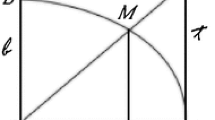Abstract
This paper is a brief introduction to how the techniques of computational complexity can be applied to real analysis—integration in particular. We investigate how the difficulty of computing a function relates to the difficulty of computing its integral. Our comments are directed to an audience that is more familiar with traditional analysis and numerical methods than it is with complexity theory.
Access this chapter
Tax calculation will be finalised at checkout
Purchases are for personal use only
Preview
Unable to display preview. Download preview PDF.
Similar content being viewed by others
References
O. Aberth. Computable Analysis. 1980. McGraw-Hill.
E. Bishop. Foundations of Constructive Analysis. 1967. McGraw-Hill.
J. M. Borwein and P. B. Borwein. On the complexity of familiar functions and numbers. Draft. Private Communication, 1986.
H. Friedman. The computational complexity of maximization and integration. Adv. in Math., 53, 1984, 80–98.
M. R. Garey and D. S. Johnson. Computers and Intractability. Freeman, 1979.
J. von zur Gathen. Feasible arithmetic computations: Valiant’s hypothesis. J. Symb. Comp., 4, 1987, 137–172.
J. von zur Gathen and G. Seroussi. Boolean circuits versus arithmetic circuits. Proc. 6th Int. Conf. in Computer Science, Santiago, Chile. 1986, 171–184.
A. Grzegorczyk. On the definition of computable real continuous functions. Fund. Math., 44, 1957, 61–71.
H. J. Hoover. Feasibly constructive analysis. Ph.D. thesis and Technical Report 206/87, Department of Computer Science, University of Toronto, 1987.
H. J. Hoover. Feasible real functions and arithmetic circuits. Technical Report TR 88-16, August 1988, Department of Computing Science, University of Alberta, Edmonton, Canada.
K. Ko and H. Friedman. Computational complexity of real functions. Theoret. Comput. Sci., 20, 1982, 323–352.
A. M. Turing. On computable numbers, with an application to the entscheidungsproblem. Proc. London Math. Soc. (2), 42, 1936/37, 230–265.
A. M. Turing. A correction. Proc. London Math. Soc. (2), 43, 1937, 544–546.
Author information
Authors and Affiliations
Editor information
Editors and Affiliations
Rights and permissions
Copyright information
© 1989 Springer-Verlag New York Inc.
About this paper
Cite this paper
Hoover, H.J. (1989). Why Integration is Hard. In: Kaltofen, E., Watt, S.M. (eds) Computers and Mathematics. Springer, New York, NY. https://doi.org/10.1007/978-1-4613-9647-5_22
Download citation
DOI: https://doi.org/10.1007/978-1-4613-9647-5_22
Publisher Name: Springer, New York, NY
Print ISBN: 978-0-387-97019-6
Online ISBN: 978-1-4613-9647-5
eBook Packages: Springer Book Archive




